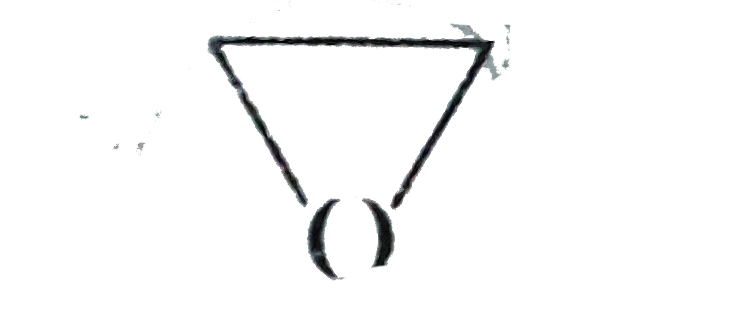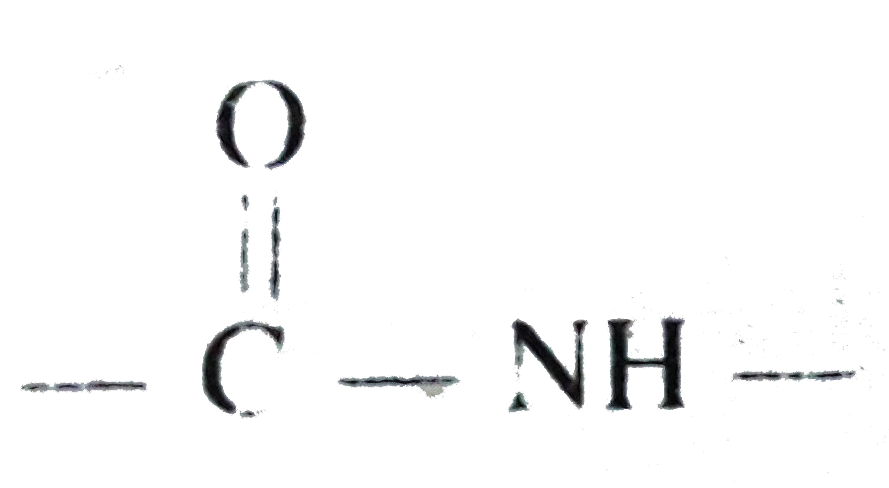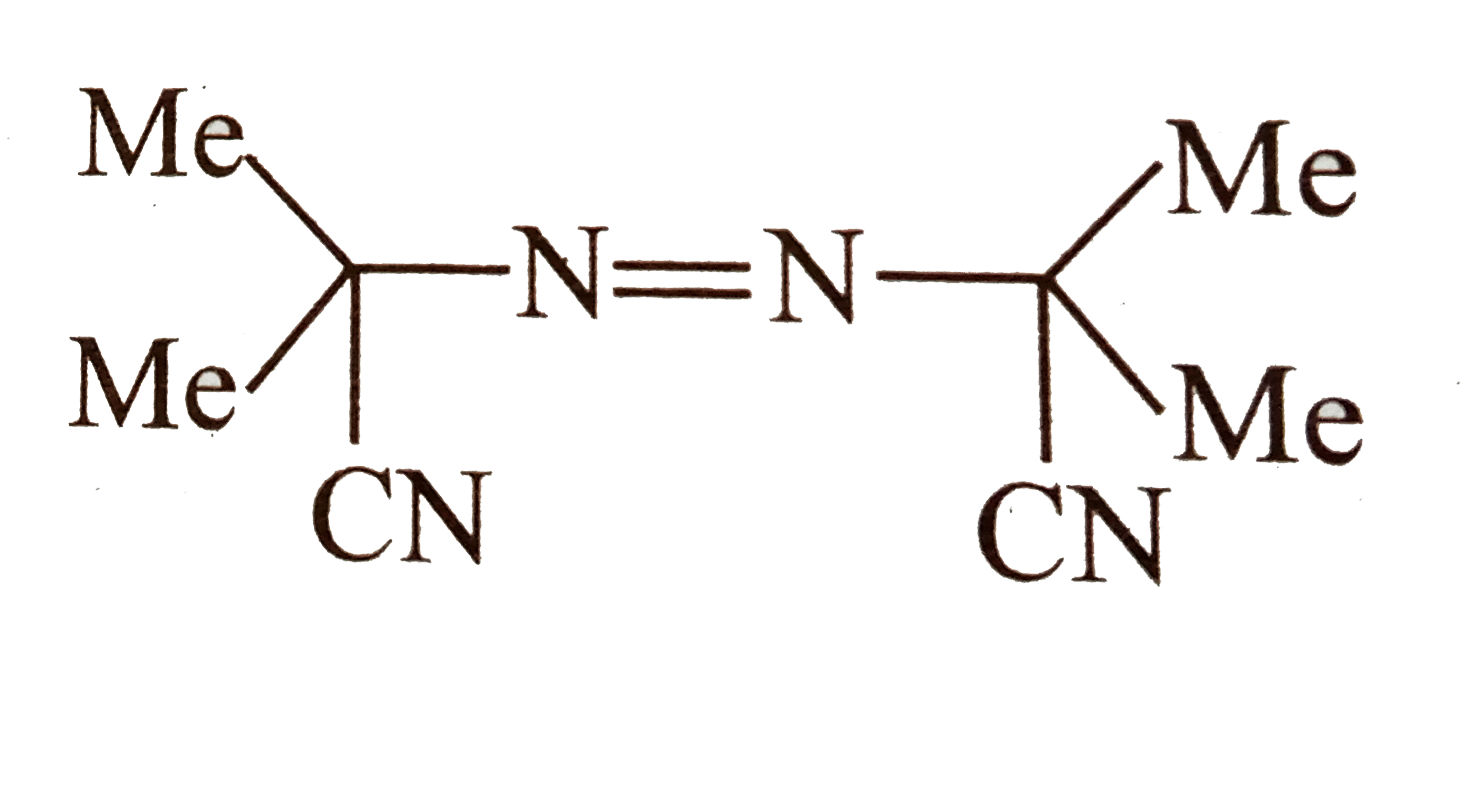(a)Why is the purest monomer used in free radical polymerisation?
(b).How does the presence oforinfluence the course of vinylic free radical polymersation.
(c )what is the monomer of the polymer given below:

HClis added to it?
(a) Trace of impurities present in alkene ,onomer can act as either chain transfer agents ro inhibitors,If it acts as a chain transfer agent,then lower-average -molecular-mass polymer is formed.If it acts as an inhibitor,the process of polumerisation is inhibited .Hence ,the pureset monomer us uded to avoid these processes.
(b)In vinylic polymerisationandacts as chain transfer agents.i.e.,it reacts eith thr growing chain to interrupt its further growth and initiat eits chain growth (i.e, produces a new radical).
The monomer is (ethylene or acidic hydrolysis of oxirane),
(ethylene or acidic hydrolysis of oxirane),
(d).This is due to the breaking or acidic hydroysis of amide bond  present in nylon.
present in nylon.
Topper's Solved these Questions
- SYNTHETIC AND NATURAL POLYMERSBOOK - CENGAGE CHEMISTRYCHAPTER - SYNTHETIC AND NATURAL POLYMERSEXERCISE - Exercises Concept Application
20 Videos
- SYNTHETIC AND NATURAL POLYMERSBOOK - CENGAGE CHEMISTRYCHAPTER - SYNTHETIC AND NATURAL POLYMERSEXERCISE - Exercises Linked Comprehension
30 Videos
- SYNTHETIC AND NATURAL POLYMERSBOOK - CENGAGE CHEMISTRYCHAPTER - SYNTHETIC AND NATURAL POLYMERSEXERCISE - Exercises Assertion Reasoning
10 Videos
- SURFACE CHEMISTRYBOOK - CENGAGE CHEMISTRYCHAPTER - SURFACE CHEMISTRYEXERCISE - Archives Subjective
2 Videos
Similar Questions
Knowledge Check
Read the following passage carefully and answer the questions given below.
Two principles are involved in the controversy about the presence of foreign controlled media in the country. The free flow of ideas and images across national borders and the need to safeguard the national interest and preserve cultural autonomy. Both are valid but both are at loggerheads because each has been used to promote less lofty goals. The principle conforms to a moral imperative freedom of expression that cannot rhyme with restrictions imposed by any government. But the free flow rhetoric also clouds the fact that the powerful Western and specially American media can and often do present, subtly or brazenly, news in a manner which promotes Western political, ideological and strategic interests. Besides, Western entertainment programmes present lifestyles and values cherished by traditional societies. All this explains why so many Indian newspapers/magazines and news agencies have sought protection from the courts to prevent foreign publications and news agencies from operating in the country. Their arguments are weak on two counts. As the bitter debate on a new world information and communication order demonstrated in the late seventies and early eighties, many of those who resent Western 'invasion' in the information and cultural fields are no great friends of democracy. Secondly, the threat of such an 'invasion' has been aired by those media groups in the developing countries who fear that their business interests will be harmed if Western groups, equipped with large financial and technological resources and superior management skills are allowed to operate in the country without let.
The fear is valid but it goes against the grain of the economic reform programme. The presence of foreign newspapers and television channels will increase competition, which in course of time, can only lead to the upgradation of dynamic Indian newspapers and television channels even while they drive the rest out of the market. One way to strike a balance between the two antagonistic principles would be to allow foreign media entry into the country, provided the Indian state treats them at par with the domestic media on all fronts. On the import of technology, for instance foreign media cannot be allowed duty concessions denied to their Indian counterparts. Foreign media will also have to face the legal consequences should they run foul of Indian laws. Why, for example, should the BBC or Time magazine or The Economist get away with showing a map of Kashmir, which is at variance with the official Indian map? Why should they go scot-free when they allow secessionists and terrorists to air their views without giving the government the right of reply? Or when they depict sexually explicit scenes which would otherwise not be cleared by the Censor Board? Since the government can do precious little in the matter, especially about satellite broadcasts, what if it should consider attaching the properties of the offending parties? Demands of this kind are bound to be voiced unless New Delhi makes it clear to the foreign media that they will have to respect Indian susceptibilities especially where it concerns the country's integrity and its culture. It may be able to derive some inspiration from France's successful attempts in the recent GATT to protect its cinematographic industry.
Which of the following is one of the points weakening the argument of prevent entry of foreign media?AThe foreign media may not be treated on par with the domestic mediaBSuch entry would be against traditional cultureCThe arguments being put forth are at loggerheadsDThe threat being voiced by those whose business will be harmed by such an entryRead the following passage carefully and answer the questions given below.
Two principles are involved in the controversy about the presence of foreign controlled media in the country. The free flow of ideas and images across national borders and the need to safeguard the national interest and preserve cultural autonomy. Both are valid but both are at loggerheads because each has been used to promote less lofty goals. The principle conforms to a moral imperative freedom of expression that cannot rhyme with restrictions imposed by any government. But the free flow rhetoric also clouds the fact that the powerful Western and specially American media can and often do present, subtly or brazenly, news in a manner which promotes Western political, ideological and strategic interests. Besides, Western entertainment programmes present lifestyles and values cherished by traditional societies. All this explains why so many Indian newspapers/magazines and news agencies have sought protection from the courts to prevent foreign publications and news agencies from operating in the country. Their arguments are weak on two counts. As the bitter debate on a new world information and communication order demonstrated in the late seventies and early eighties, many of those who resent Western 'invasion' in the information and cultural fields are no great friends of democracy. Secondly, the threat of such an 'invasion' has been aired by those media groups in the developing countries who fear that their business interests will be harmed if Western groups, equipped with large financial and technological resources and superior management skills are allowed to operate in the country without let.
The fear is valid but it goes against the grain of the economic reform programme. The presence of foreign newspapers and television channels will increase competition, which in course of time, can only lead to the upgradation of dynamic Indian newspapers and television channels even while they drive the rest out of the market. One way to strike a balance between the two antagonistic principles would be to allow foreign media entry into the country, provided the Indian state treats them at par with the domestic media on all fronts. On the import of technology, for instance foreign media cannot be allowed duty concessions denied to their Indian counterparts. Foreign media will also have to face the legal consequences should they run foul of Indian laws. Why, for example, should the BBC or Time magazine or The Economist get away with showing a map of Kashmir, which is at variance with the official Indian map? Why should they go scot-free when they allow secessionists and terrorists to air their views without giving the government the right of reply? Or when they depict sexually explicit scenes which would otherwise not be cleared by the Censor Board? Since the government can do precious little in the matter, especially about satellite broadcasts, what if it should consider attaching the properties of the offending parties? Demands of this kind are bound to be voiced unless New Delhi makes it clear to the foreign media that they will have to respect Indian susceptibilities especially where it concerns the country's integrity and its culture. It may be able to derive some inspiration from France's successful attempts in the recent GATT to protect its cinematographic industry.
A country has been cited as having succeeded in protecting which of the following?ANews agenciesBTelevisionCGATTDNone of the aboveRead the following passage carefully and answer the questions given below.
Two principles are involved in the controversy about the presence of foreign controlled media in the country. The free flow of ideas and images across national borders and the need to safeguard the national interest and preserve cultural autonomy. Both are valid but both are at loggerheads because each has been used to promote less lofty goals. The principle conforms to a moral imperative freedom of expression that cannot rhyme with restrictions imposed by any government. But the free flow rhetoric also clouds the fact that the powerful Western and specially American media can and often do present, subtly or brazenly, news in a manner which promotes Western political, ideological and strategic interests. Besides, Western entertainment programmes present lifestyles and values cherished by traditional societies. All this explains why so many Indian newspapers/magazines and news agencies have sought protection from the courts to prevent foreign publications and news agencies from operating in the country. Their arguments are weak on two counts. As the bitter debate on a new world information and communication order demonstrated in the late seventies and early eighties, many of those who resent Western 'invasion' in the information and cultural fields are no great friends of democracy. Secondly, the threat of such an 'invasion' has been aired by those media groups in the developing countries who fear that their business interests will be harmed if Western groups, equipped with large financial and technological resources and superior management skills are allowed to operate in the country without let.
The fear is valid but it goes against the grain of the economic reform programme. The presence of foreign newspapers and television channels will increase competition, which in course of time, can only lead to the upgradation of dynamic Indian newspapers and television channels even while they drive the rest out of the market. One way to strike a balance between the two antagonistic principles would be to allow foreign media entry into the country, provided the Indian state treats them at par with the domestic media on all fronts. On the import of technology, for instance foreign media cannot be allowed duty concessions denied to their Indian counterparts. Foreign media will also have to face the legal consequences should they run foul of Indian laws. Why, for example, should the BBC or Time magazine or The Economist get away with showing a map of Kashmir, which is at variance with the official Indian map? Why should they go scot-free when they allow secessionists and terrorists to air their views without giving the government the right of reply? Or when they depict sexually explicit scenes which would otherwise not be cleared by the Censor Board? Since the government can do precious little in the matter, especially about satellite broadcasts, what if it should consider attaching the properties of the offending parties? Demands of this kind are bound to be voiced unless New Delhi makes it clear to the foreign media that they will have to respect Indian susceptibilities especially where it concerns the country's integrity and its culture. It may be able to derive some inspiration from France's successful attempts in the recent GATT to protect its cinematographic industry.
Why should the entry of foreign media harm local interests?ADifferent sets of rules and laws were made applicable for foreign mediaBEconomic reform programmes will get a setbackCThe cultural heritage will be lostDThey are better equipped managerially and technologically
a.

What is the relative abstraction of H and D ?
b. Why free-radical chlorination of CH4 is nearly 11 times faster than CD4 ?
View Solutiona.

What is the relative abstraction of H and D ?
b. Why free-radical chlorination of CH4 is nearly 11 times faster than CD4 ?
View SolutionAnswer the following questions
(a) In a single slit diffraction experiment, the width of the slit is made double the original width. How does this affect the size and intensity of the central diffraction band?
(b) In what way is diffraction from each slit related to the interference pattern in a double-slit experiment?
(c) When a tiny circular obstacle is placed in the path of light from a distant source, a bright spot is seen at the centre of the shadow of the obstacle. Explain why?
(d) Two students are separated by a 7 m partition wall in a room 10 m high. If both light and sound waves can bend around obstacles, how is it that the students are unable to see each other even though they can converse easily
(e) Ray optics is based on the assumption that light travels in a straight line. Diffraction effects (observed when light propagates through small apertures/slits or around small obstacles) disprove this assumption. Yet the ray optics assumption is so commonly used in understanding location and several other properties of images in optical instruments. What is the justification?
View SolutionRead the given passage and answer questions number 1 to 5 that follow :
A variety of alkenes or dienes and their derivatives are polymerised in the presence of a free radical generating initiator (catalyst) like benzoyl peroxide, acetyl peroxide, tert-butyl peroxide, etc. For example, the polymerisation of ethene to polythene consists of heating or exposing to light a mixture of ethene with a small amount of benzoyl peroxide initiator. The process starts with the addition of phenyl free radical formed by the peroxide to the ethene double bond thus generating a new and larger free radical. This step is called chain initiating step. As this radical reacts with another molecule of ethene, another bigger sized radical is formed. The repetition of this sequence with new and bigger radicals carries the reaction forward and the step is termed as chain propagating step. Ultimately, at some stage the product radical thus formed reacts with another radical to form the polymerised product. This step is called the chain terminating step.
How does the free radical combine with the monomer? Show the reaction with ethene as monomer and benzoyl peroxide as the initiator.
View Solutionfor scattering by an inverse square law field (such as that produced by a charged nucleus in Rutherford's model), the relation between impact parameter b and the scattering angle θ is given by
b=Ze2cotθ/24π∈0(12mv2)
(a) What is the scattering angle for b=0?
(b) for given impact parameter, b, does the angle of deflection increase or decrease with increase in energy?
(c) What is the impact parameter at which the scattering angle is 90∘ for Z=79 and initial energy=10MeV?
(d) Why is it that the mass of the nucleus does not enter the formula above, but its charge does?
(e) for a given energy of the projectile, does the scattering angle increase or decrease with decrease in impact parameter?
View Solution
